|
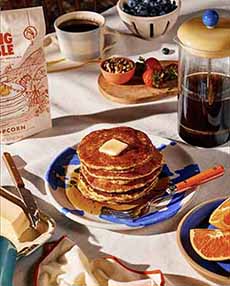
[1] Hot off the griddle: popcorn pancakes (photos #1, #2, #3, #6, #7, #8, #9 © Long Table Pancakes).
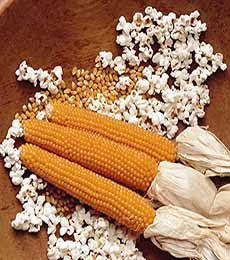
[2] An ear of popcorn looks like regular corn, but extra moisture in the kernels allows it to pop (photo © C Z Grains).
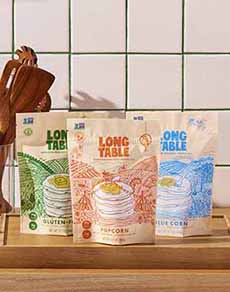
[3] The three varieties of Long Table heirloom pancake and flour blends.
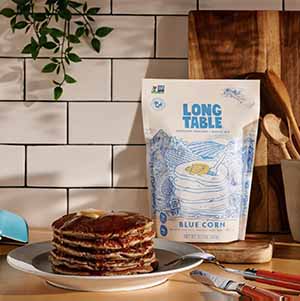
[4] Blue Corn Pancake & Waffle Mix.
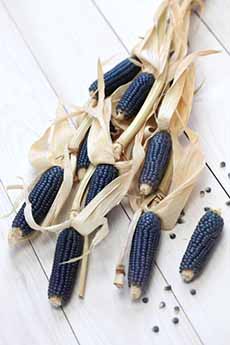
[5] Ears of blue corn (photo © Asimojet | Panther Media).
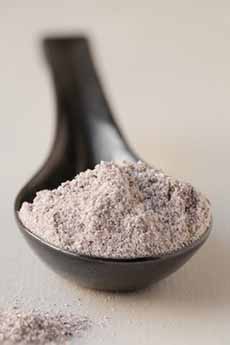
[6] Finely-ground blue cornmeal (photo © Anson Mills).
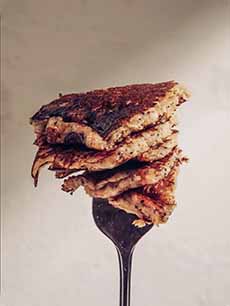
[7] A forkful of popcorn pancakes.
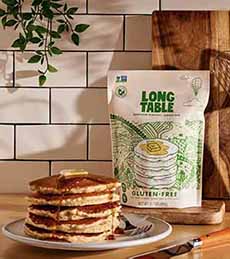
[8] Gluten-free whole grain pancake mix.
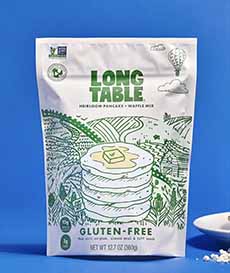
[9] A great gift for anyone on a gluten-free diet.
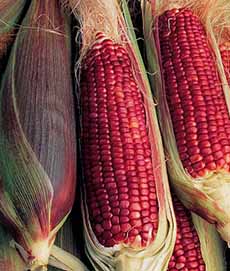
[9] Red corn is used in the gluten-free mix (photo © Burpee).
|
|
Last year, The Nibble discovered Long Table’s Blue Corn Pancake & Waffle Flour, which has become a household favorite. (What is blue corn? See below.)
The line was launched as a nutrient-dense*, whole grain pancake and waffle brand (we’ve even made blue cornbread from the flour).
The three varieties—Blue Corn, Popcorn, and Gluten-Free—are blends of different grains and meals. It the genius of blending that gives each variety such depth of flavor.
This specialty line is our Top Pick Of The Week.
BLUE CORN PANCAKE & WAFFLE FLOUR
While the ears of corn are blue (photo #5), the flour is much lighter (photo #6), but we focus on the flavor, not the color. Once, we added a drop of blue food coloring to the batter. While cute, it’s not essential.
Where does the blue color come from?
Anthocyanin, an antioxidant, is the pigment that. Depending on the pH level of the soil, it makes the fruit or grain blue, red, purple, or black. (For example, red raspberries and black raspberries also get their color from anthocyanin.)
The blue corn blend consists of:
Heirloom organic blue corn
Heirloom organic rye
Heirloom organic buckwheat
on-GMO hazelnut meal
The flour has 11g protein per serving†—not from protein powder† but from their natural, unprocessed, whole-food state. There are also 5g fiber per serving from the whole grains.
What Is Blue Corn?
Blue corn, also known as Hopi maize or Rio Grande Blue, is a variety of flint corn (Zea mays) that has been cultivated for centuries by Native American peoples, particularly in the American Southwest.
The kernels range in color from dark blue to purple-blue. The color derives from the antioxidant pigment anthocyanin (the same pigment found in blueberries).
The kernels are generally smaller and more cylindrical kernels than yellow corn, with a higher protein content and a lower glycemic index than white or yellow corn. Blue corn also contains more zinc and iron.
These days you can find blue tortilla chips, cornmeal, flour, and tortillas (plus other foods and beverages).
POPCORN PANCAKE & WAFFLE FLOUR
Yes, there is a special variety of corn called popcorn (Zea mays everta), which was discovered and bred thousands of years ago when corn kernels accidentally dropped by the fire popped.
The popcorn flour is a blend of:
Heirloom Non-GMO popped popcorn flour
Heirloom organic oat flour
Heirloom organic wheat
Non-GMO almond meal
Non-GMO poppy seeds
What Is Popcorn Flour Like?
Slightly sweet, toasted corn flavor with more concentrated corn flavor than regular cornmeal, and a light and fluffy texture.
Naturally gluten-free.
It an be used as a thickener for soups and sauces, like cornstarch.
It cannot fully replace wheat flour in recipes due to lack of gluten, and works best when mixed with other flours.
It has a shorter shelf life due to the natural oils in the popcorn, and more expensive than regular cornmeal due to extra production steps: popping and sifting.
GLUTEN-FREE PANCAKE & WAFFLE FLOUR
The gluten-free blend (photos #8 and #9) is certified gluten-free by Beyond Celiac and the National Foundation for Celiac Awareness. It’s whole grain and high protein, a blend of:
Heirloom organic sorghum
Heirloom organic red cornmeal (photo #10)
Non-GMO almond meal
Non-GMO teff seeds
All three varieties are whole-grain and great year-round gifts for pancake and waffle lovers. Trust us, the flavors are so much more exciting than even many top artisan brands.
> The history of corn.
> The history of popcorn.
> How about a popcorn salad?
> What are whole grains?
> What are heirloom grains (below).
> A year of corn holidays (below).
GET YOUR LONG TABLE PANCAKE & WAFFLE FLOUR
> Head to LongTablePancakes.com.
We not only eat them at home, we buy them as party favors, stocking stuffers, and teacher gifts.
Don’t compare the prices to supermarket brands. Long Table is in a different league.
WHAT ARE HEIRLOOM GRAINS
Heirloom grains are the opposite of heavily industrialized grains (what you mostly see at supermarkets and other grocers). They’re whole grains that are not genetically modified and are prized for their superior flavor and nutrition.
They are typically varieties that were developed before World War II and have had limited breeding selection since. (Selective breeding is a process where humans deliberately choose organisms with desired traits to produce offspring with those same characteristics. They are not artificially modified like GMOs because it uses natural reproduction over multiple generations instead of genetic modification.
Heirloom and ancient grains don’t have formal recognized definitions by science or government regulator bodies (e.g. the USDA), so we’ve set forth the differences below.
Flavor. They have deeper, richer flavor, more fiber, and more minerals and antioxidants.
Gluten. If they have gluten, their gluten structures are also gentler and easier to digest [source].
Gluten-free. Some categories, like corn, are naturally gluten-free. However, unless the GF certification is on the bag, the corn may have been processed in facilities or with harvest equipment that also handle wheat. Growing corn in a field next to wheat or in rotation with wheat can also result in cross-contamination.
Plant and animal DNA can be altered for a number of reasons‡. Heirloom grains have not been genetically modified or altered in any way**.
Heirloom Grains Vs. Ancient Grains
We tend to think of ancient grains as originating thousands of years ago, raised by indigenous cultures around the world.
Heirloom grains can be ancient grains, when they come from plants that have been grown from the exact same seed line for hundreds if not thousands of years. They have not been genetically modified or altered in any way and are considered valuable for reasons ranging from superior flavor and nutrition to hardiness and adaptability.
Heirloom grains more typically describe varieties that were brought by immigrants to the New World. Examples include turkey red wheat from the Ukraine, blue emmer wheat from Ethiopia, and Khorasan wheat from Egypt.
The farmers who grow heirloom grains are interested in agricultural diversity and ensuring that these seed varieties are not lost (i.e., cease being planted) because of cost and other issues.
As consumers are becoming more aware of sustainability, farmers and other agricultural stakeholders are working together to increase the accessibility of heirloom grains [source Claude.ai].
A YEAR OF CORN HOLIDAYS
January 19: National Popcorn Day
January 29: National Corn Chip Day
March, third Saturday: National Corn Dog Day
April 6: National Caramel Popcorn Day
July: National Corn Month
June 11: National Corn On The Cob Day
July 16: National Corn Fritters Day
October 30: National Candy Corn Day
December 2: Business Of Corn Day††
|
________________
*Nutrient-dense foods are all about health and nutrition: foods that are high in nutrients and relatively low in calories. They contain vitamins, minerals, complex carbohydrates, lean protein, and healthy fats. Examples include fruits and vegetables, whole grains (like blue corn and popcorn flours plus these), lean meats, salmon and sardines which are heart-healthy (high in omega-3 fatty acids), beans and nuts, and eggs. A wild card here: edamame, which you can find frozen, is a soy food that is high in fiber, protein, iron, potassium, calcium, magnesium, and folate. Eating more nutrient-dense foods will help you avoid processed foods, which are often calorie-dense.
†Protein powder is made from powdered protein, which can come from a variety of plant and animal sources. They can be made into shakes with water or milk, or added to smoothies. They may may also include other ingredients, such as added sweetener, flavoring, thickeners, vitamins, and minerals.
> Whey and casein: These are proteins derived from milk. Whey is a byproduct of cheese making and is considered a complete protein because it contains all nine essential amino acids. Casein is a slow-release protein that can help prevent muscle breakdown overnight.
> Eggs.
> Plants: E.g. the proteins in soybeans, peas, rice, potatoes, and hemp. For example, hemp is a good source of omega-3 and omega-6 fatty acids, as well as minerals like potassium, phosphorus, and magnesium.
††The Business Of Corn holiday commemorates the invention of the first large-scale commercial oil popcorn popper by Charles Cretors in 1885.
‡The process of developing a new genetically modified crop can take up to 12 years. Plant genes are genetically modified for improvement such as:
> Increased yield.
> Better nutrition.
> Resistance to pests and disease.
> Tolerance to environmental conditions like drought.
> Reduced use of pesticides.
> Longer shelf life [source: Chat GPT].
**The benefits of non-GMO foods include:
> Environmental considerations: reduced pesticide use in some non-GMO farming systems, protection of non-target organisms like beneficial insects, support for traditional seed-saving and crop diversity.
> Market benefits: consumer preferences for traditionally bred/non-GMO foods, potential price premiums for farmers, easier access to export markets that forbid GMOs.
> Social and economic aspects: support for traditional farming practices, less dependence on patented seed technologies, greater farmer control over seed selection.
It’s important to note that the scientific consensus is that approved GMO foods are as safe as non-GMO foods. The choice between GMO and non-GMO foods often comes down to personal preferences regarding farming practices, environmental impact, and economic factors rather than safety concerns [source: Claude.ai].
‡‡The key differences between heirloom grains and ancient grains:
> Heirloom grains are “younger,” from seeds passed down through generations of farmers for decades or hundreds of years, typically ending pre-1950s. They may have been cross-bred for superior performance, but not genetically modified.
> Heirloom grains are open-pollinated varieties that breed true-to-type. Examples include: Bloody Butcher Corn, Jimmy Red Corn, Red Fife Wheat, Turkey Red Wheat.
> Ancient grains are species that have remained largely unchanged over thousands of years. They were staple foods of the world’s ancient civilizations.
> Examples include: amaranth (Aztec civilization), buckwheat (southwestern China), einkorn (earliest cultivated wheat from northern Mesopotamia in the Fertile Crescent, specifically in the Karacadağ Mountains region of southeastern Turkey near the Syrian border), Kamut/khorasan wheat (Egypt), millet (East Asia), Quinoa (Andes/Incas), Spelt (also known as dinkel wheat or hulled wheat, from Bronze Age Europe), Teff (Ethiopia and Eritrea, naturally gluten-free.
CHECK OUT WHAT’S HAPPENING ON OUR HOME PAGE, THENIBBLE.COM.
|












